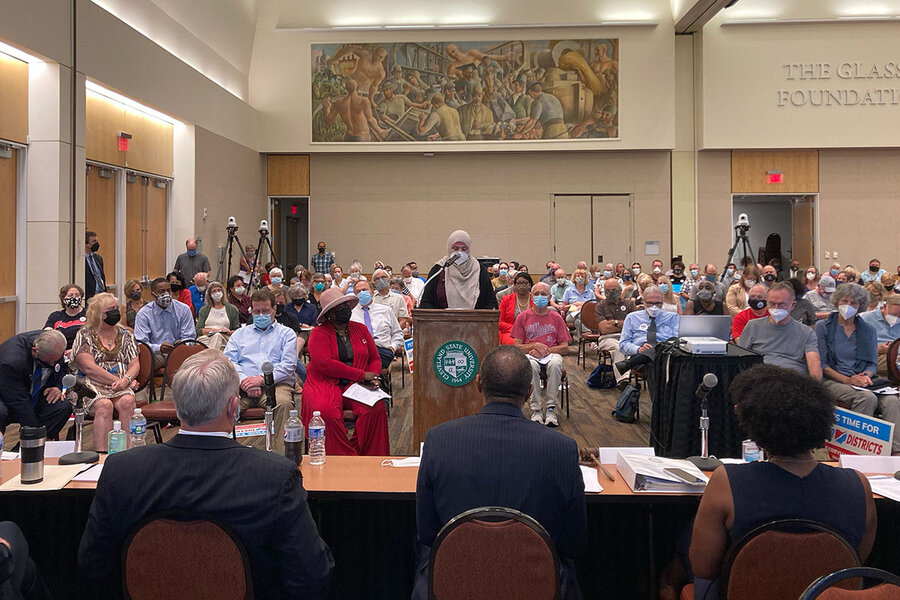Out of bounds? Why Ohio’s redistricting fight matters.
Loading...
Of the states where redistricting has devolved into chaos this year, Republican-run Ohio stands out for its legal labyrinths and political hardball. It also underlines the limits of state courts in trying to settle disputes when politicians refuse to give ground.
Redistricting – the once-a-decade redrawing of congressional and statehouse boundaries – is often an exercise in raw power, manipulated by the party in the majority to try to gain seats.
Why We Wrote This
Among states where redistricting reform efforts have gone awry, Ohio shows the limits of state courts to address a stalemate and how running out the clock can pay off.
Last week, Ohio’s Supreme Court rejected its Republican-drawn congressional map as unconstitutional. Yet the state’s congressional primaries have already been held, and the districts can’t be changed before the next election in 2024.
The same goes for the state legislature, whose primaries are next week. Those maps, too, were rejected by the state’s high court – but after subsequent maps were also deemed flawed, a federal court ordered the state to adopt the rejected maps and move ahead with elections.
To reformers, it all feels like a game of “Heads I win, tails you lose.”
“Redistricting is the most powerful process we have when it comes to who holds power,” says Jeniece Brock of the Ohio Organizing Collaborative. “When I look at that map, I don’t see a true representation of Ohioans.”
For the second time this year, voters in Ohio next week will head to the polls. And just as in May, when the state held its congressional primaries, it will be using maps – this time for the state legislature – that Ohio’s highest court struck down as unconstitutional.
If that sounds like an anomaly, it’s not. Two other states, Alabama and Louisiana, are also using maps this year that courts had found to violate the rights of voters.
It’s all part of the once-a-decade battle over redrawing political boundaries to reflect shifts in population within and between states. Often an exercise in raw power, the redistricting process is frequently manipulated by both parties to try to gain more seats. In a closely divided House of Representatives, any extra edge from diluting the other side’s votes could be enough to flip control.
Why We Wrote This
Among states where redistricting reform efforts have gone awry, Ohio shows the limits of state courts to address a stalemate and how running out the clock can pay off.
In recent years, reform advocates in some states have used ballot initiatives and lawsuits to try to curb the power of politicians to produce partisan maps. Other states have turned to independent commissions to draw fairer district lines. But in many red and blue states, redistricting is still employed for political gain, which is one reason why the vast majority of U.S. House seats today are uncompetitive.
Of the states where the redistricting process has devolved into chaos this year, Republican-run Ohio stands out for its legal labyrinths and political hardball, as well as the dashed hopes of reformers. It also underlines the limits of state courts in trying to settle disputes over gerrymanders when politicians refuse to give ground.
Last week, Ohio’s Supreme Court again rejected its congressional map as unconstitutional. Yet the state’s congressional primaries have already been held and the districts can’t be changed before the next election in 2024 – essentially rewarding the politicians who ran down the clock.
The same goes for the statehouse map that is being used next week. It was deemed by the state court to unfairly advantage Republicans, who already hold a three-quarters majority in the state assembly, far more than the overall partisan lean in Ohio. And as reformers point out, unchecked control of state government is what allows politicians to gerrymander maps – making it feel like a game of “Heads I win, tails you lose.”
“Redistricting is the most powerful process we have when it comes to who holds power,” says Jeniece Brock, policy and advocacy director for Ohio Organizing Collaborative, one of the plaintiffs in the litigation. “When I look at that [state legislature] map, I don’t see a true representation of Ohioans and their voter preferences.”
Amendment banning gerrymandering
In 2015, Ohio voters approved a ballot initiative to create a bipartisan redistricting commission. A subsequent amendment to the state constitution mandated that districts should not be redrawn for partisan gain.
So when Republicans on the redistricting commission adopted what seemed to be a set of partisan maps based on the 2020 census, reformers sued in state court.
The venue made sense: In 2019, the U.S. Supreme Court had ruled that partisan gerrymanders may be undemocratic but that federal courts couldn’t adjudicate them, putting the onus on state courts to apply standards of fairness under state law.
In January, Ohio’s Supreme Court struck down both the federal and state maps as unconstitutional and ordered the commission to draw new ones that better reflected Ohio’s partisan balance. In both landmark rulings, Chief Justice Maureen O’Connor, a Republican, was the swing vote.
The court noted that Republicans average an 8-point advantage in statewide elections. But the proposed maps would have yielded more lopsided GOP majorities.
Republicans contend that it’s virtually impossible to draw districts that reflect the state’s partisan balance – 54% to 46% – due to the sorting of Democrats into urban areas and Republicans into rural ones. Gov. Mike DeWine, a Republican, defended Ohio’s maps as keeping communities together in right-sized districts, calling the congressional map “fair, compact, and competitive.”
After its maps were invalidated, Ohio’s redistricting commission struggled to find a path forward. Over the complaints of Democrats on the seven-person commission, Republicans submitted four more sets of state legislative maps, all of which were ruled invalid by the Supreme Court.
“They basically decided to dig in and go for broke,” says Jonathan Entin, a professor emeritus of law at Case Western Reserve University. “They took maximal positions at every stage of the process.”
Doug Spencer, an associate law professor at the University of Colorado who studies redistricting, says Ohio faced “a state level constitutional crisis,” as a result of these hardball tactics. Ohio’s Supreme Court seemed to have no remedy, since it lacked the authority to impose alternative maps. And it was reluctant to hold the redistricting commission’s GOP members, who included Governor DeWine and Secretary of State Frank LaRose, in contempt for ignoring its rulings.
Two states, two very different outcomes
The contrast with New York is instructive. After Democrats there produced an aggressive gerrymander, ignoring a constitutional ban on the practice, the state’s highest court struck down the maps and outsourced the whole process to an independent mapmaker in April. That provided a way forward after Democrats had run roughshod over a similar bipartisan commission, to the frustration of Republicans who are in the minority.
In Ohio, the standoff between the state Supreme Court and the legislature was broken after a conservative activist sued in federal court to force the state to hold a primary. In a 2-1 verdict, a federal district court ruled that Ohio must use one of the rejected statehouse maps if the commission failed to produce an acceptable one, calling it “the least flawed option to vindicate the fundamental right to vote” in 2022. (The federal maps weren’t affected by the ruling.)
“As of today, no map exists, uncertainty persists, and nothing ensures that a state-legislative election will happen at all. This court’s intervention, however, can restore a lawful and orderly election by ensuring Ohio voters, candidates, and officials know the districts that will apply,” it wrote.
Legal experts expressed surprise that Ohio’s highest court had been overruled. “It’s really unusual for a federal court to say we will essentially ignore the state Supreme Court’s interpretation of state law,” says Professor Entin. The ruling also seemed to benefit the politicians who had repeatedly defied the state court, he adds.
In a dissenting opinion, one of the judges echoed this complaint. Judge Algenon Marbley argued Ohio’s Republican politicians had relied on the court “to rescue their unlawful redistricting plan once they had manufactured a sufficient emergency.”
Judge Marbley was appointed to the bench by President Bill Clinton. The two judges who wrote the majority opinion were both appointees of President Donald Trump.
“The optics are terrible,” says Mark Brown, who teaches constitutional law at Capital University Law School in Columbus and filed an amicus brief in support of the plaintiffs in the redistricting lawsuit. “It looks like the federal court lining up along partisan lines.”
For the invalidated maps adopted in Alabama and Louisiana, the same could be said of the U.S. Supreme Court, which stayed the verdicts of federal courts that had found the redistricting processes had violated the constitutional rights of Black voters in both states.
The Supreme Court also recently agreed to hear a claim by Republicans in North Carolina that their state’s judiciary had no right to strike down its congressional maps, arguing the legislature should have the final word. If upheld, that argument could undo all the efforts of reformers to prevent self-interested politicians from drawing boundaries for their own seats. A ruling is expected next year.
Politics and the courts
The next round in Ohio’s redistricting wars could be determined as much by politics as law.
Chief Justice O’Connor is due to retire this year, opening up the top seat on Ohio’s Supreme Court. One of the candidates vying for the elected position is Justice Sharon Kennedy, a Republican, who dissented in the redistricting rulings, arguing that the court didn’t have the authority to strike down the maps.
A victory for Justice Kennedy in November’s midterms would leave a vacancy on the court that Governor DeWine could then fill with an interim judge before the next election. That could embolden Republicans on the redistricting commission to tilt the next set of maps in their favor in expectation of a more conciliatory court review.
“I suspect that the Republicans, with their gerrymandered districts, will win a supermajority in the general assembly and will be in a situation to do it [gerrymandering] again next time. Why would they do anything different?” asks Professor Brown.
Even if Ohio were to adopt fairer electoral maps, its Statehouse would almost certainly still be Republican-run, given the statewide partisan lean and distribution of voters. But Republican lawmakers from more competitive districts might, in theory at least, want to reach across the aisle on certain issues.
But that’s unlikely as long as Republicans know they won’t face any meaningful opposition at election time because of how the maps are drawn. “They live in districts they could never lose,” says David Pepper, a former Democratic state chairman.










